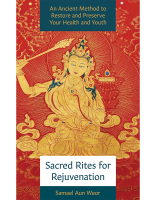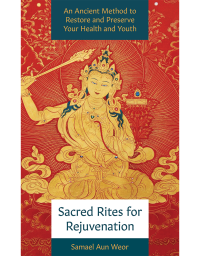The following text is transcribed from oral instructions given by Samael Aun Weor to a student. The transcribed text was initially published by that student decades ago in Spanish in the form of a narrative, and included many personal anecdotes and writings unrelated to the teachings. In later years, other Gnostic students decided to publish an edition that removed the extraneous material, resulting in a series of completely unrelated chapters. In 2008, Glorian Publishing translated and published the first English edition of that book. However, new readers were very confused by the jumbled collection of chapters, causing many to believe that Samael Aun Weor wrote the book in that form, which reflected badly on the teachings. In this edition, we have removed the extraneous chapters and focused entirely on the practical rites.
Furthermore, this book should not be read as an introduction to the teachings, nor even as a thorough explanation of the exercises themselves. These exercises come from an ancient, protected tradition whose full depth can be accessed only by those who put these exercises into practice and awaken their consciousness.
Yantra Yoga
The Sanskrit word yantra implies “restraint” or “firm support,” and can literally be translated as “machine, instrument.” The word yantra has different implications depending upon which tradition is using it.
In Hinduism, this term is usually used in Hindu Tantra (esoteric teachings) in reference to mystical diagrams or forms utilized in meditation.
In Buddhism, yantra refers to a series of bodily movements taught in Buddhist Tantra to specially prepared students. The Indian Tantric Master Padmasambhava and his student, a Tibetan scholar and monk named Vairochana, are credited with establishing Buddhism in Tibet (especially Dzogchen) in the eighth century A.D., as well as setting the foundations for Tibetan medicine and a highly sophisticated series of physical and energetic exercises called “Yantra Yoga” (Tibetan: ‘khrul ‘khor) whose purpose was to establish a strong foundation for spiritual development. Today, these exercises are practiced in some of the schools of Tibetan Buddhism, but kept only amongst the initiated. As Samael Aun Weor said in the following book, some of these exercises have been described publicly, but in an incomplete form.
The true Yantric exercises have some relationship with Hatha Yoga (now very popular in the West), Chi Gung, and various martial arts, all of which originated with the intention of keeping the physical body fit enough to withstand the intense demands of spiritual development. Clearly, Hatha Yoga and the martial arts have largely forgotten their spiritually-focused roots, the evidence of which is their complete inability to awaken the consciousness of their practitioners. The exercises described in this book, however, are very different, and when practiced faithfully, can awaken the consciousness and provide many other essential benefits.
Among the Tibetan Buddhist schools, there are several variations and lineages of Yantra Yoga. The exercises taught in this book are drawn from but not identical to those traditions. As stated herein:
“These rites are not the exclusive patrimony of anyone. There are some monasteries in the Himalayas and in other places where these rites are practiced, mainly in a monastery that is called “The Fountain of Youth”...
“I obtained some data from the mentioned monastery, which I know very well, and other data from other schools in India that I also know very well.”
Terminology
These exercises have been known by various names, notably called by Gnostic students “the Tibetan rites” or “the lamasery exercises.” It is important to note that the term “lamasery” did not originate in Asia, but was invented by Westerners. Samael Aun Weor used the term as was conventional at the time he was teaching. However, in the spirit of continual improvement that he followed, and with respect to the tradition from which these exercises are derived, we prefer not to perpetuate the use of the term. Therefore, in this book we have exchanged the misnomer “lamasery” for the more accurate and appropriate term “monastery.”
To aid your study of this profound book, we have included a short glossary of terms at the end. You can find a much more detailed glossary at glorian.org.
Mantra Pronunciation
In this book the author provides mantras for our benefit. Chanting or repetition of sacred sounds is universal in all religions. In Sanskrit, these sounds are called mantras, and their repetition is called japa.
Generally speaking, the sounds in mantras are pronounced using the ancient roots (Latin, Greek, Hebrew, Sanskrit, etc):
- I: as the ee in “tree”
- E: as the eh in “they”
- O: as the oh in “holy”
- U: as the u in “true”
- A: as the ah in “father”
- M: extended as if humming, “mmmmm”
- S: extended like a hiss, “sssss”
- CH: if the word is Latin, pronounced as k. If the word is Hebrew, pronounced as a scrape in the back of the throat, as in “Bach”
- G: In most mantras, G is pronounced as in “give”
Should Mantras be Spoken Aloud or Silent?
“...the verb is of triple pronunciation and that it endows three norms: verbal, mental, and conscious. One can articulate with the creative larynx, one can vocalize with his thought, and one can vocalize with the superlative consciousness of the Being.” –Samael Aun Weor, Esoteric Medicine and Practical Magic
“There are three ways that one learns to use a mantra, to repeat prayers or sounds. They are quite simple: aloud, quietly, or silently.
Vaikhari Japa: verbal, loud
Upamshu Japa: whispered or hummed
Manasika Japa: mental, silent, without moving.” –the lecture Yoga of Devotion
“The fruits of whispered japa are a thousand times more powerful than the verbal japa, and the fruits of the silent, mental japa are hundreds of thousands of times more powerful than the verbal japa. Mental japa can even be kept up while at work.” –Swami Sivananda







